Space, the final frontier. The starship Enterprise pursues its mission to explore the galaxy, when all communication channels are suddenly cut off by an impenetrable nebula. In many episodes of the iconic TV series, the valiant crew must “tech the tech” and “science the science” within just 45 minutes of airtime in order to facilitate their escape from this or a similar predicament before the end credits roll. Despite spending a significantly longer time in their laboratories, a team of scientists from the University of Rostock has succeeded in developing an entirely new approach for the design of artificial materials that can transmit light signals without any distortions by means of precisely tuned flows of energy. They have published their results in Science Advances.
“When light spreads in an inhomogeneous medium, it undergoes scattering. This effect quickly transforms a compact, directed beam into a diffuse glow, and is familiar to all of us from summer clouds and autumn fog alike,” Professor Alexander Szameit of the Institute for Physics at the University of Rostock describes the starting point of his team’s considerations. Notably, it is the microscopic density distribution of a material that dictates the specifics of scattering. Szameit continues, “The fundamental idea of induced transparency is to take advantage of a much lesser-known optical property to clear a path for the beam, so to speak.”
This second property, known in the field of photonics under the arcane title of non-Hermiticity, describes the flow of energy, or, more precisely, the amplification and attenuation of light. Intuitively, the associated effects may seem undesirable—particularly the fading of a light beam due to absorption would seem highly counterproductive to the task of improving signal transmission. Nevertheless, non-Hermitian effects have become a key aspect of modern optics, and an entire field of research strives to harness the sophisticated interplay of losses and amplification for advanced functionalities.








